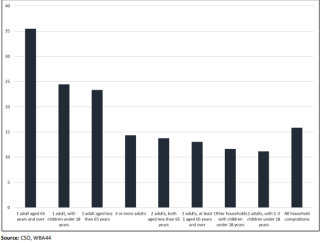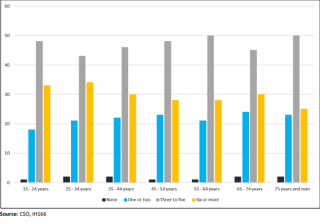Towards Wellbeing For All - Community, Connections and Participation

The Programme for Government acknowledged that our “existing measures of economic performance fail to measure matters such as damage to the environment and voluntary work. They also overlook equality of opportunity, distribution of wealth and income and only value public expenditure on the basis of the inputs used, not the outcomes achieved” and committed to introducing a series of indicators that would more accurately measure wellbeing to provide a “holistic view of how our society is faring”.
A ‘Wellbeing Dashboard’ was then developed to provide a snapshot of progress. In developing the Dashboard, the Inter-Departmental Working Group established a list of 35 indicators chosen to be balanced, add value or be of policy relevance, provide for aggregation and dis-aggregation, be readily available and of sufficient quality, and be internationally comparable.
So how are we doing? To gauge public opinion on what matters, and what should therefore be counted as an indicator of Well-being, Social Justice Ireland produced a survey asking people to rank a set of six indicators under each of the Well-being Framework dimensions from one to six, with one being the least important and six being the most important. The six indicators included the indicators used in the Dashboard and datasets readily available from the CSO and other reputable sources. This survey was circulated over the Summer months through our social media channels, our Weekly Digest, and our Members Bulletin. What follows is based on the responses to this survey and our policy proposals under each of the 11 dimensions.
The proportion of the population who reported feeling lonely at least some of the time was 16.6 per cent in 2018.
Studies on loneliness in Ireland have tended to concentrate on older people aged 50+ using data from the TILDA study, which may be understandable given the correlation with age (Chart 1) and indeed the CSO Report on this aspect in the SILC 2018 Module suggests that loneliness increases with age (with the exception of 16–24-year-olds who have the second highest rate of loneliness). However, learnings in respect of differences in social isolation among people living in urban or rural areas; loneliness by highest education achieved [1], the impact of loneliness on health outcomes and mortality risk would be worthy of study at a population level.
Chart 1: Proportion of the population who felt lonely “Some or Most of the Time”, 2018

The CSO’s Household Environmental Behaviours – Visits to Nature Areas Report Q3 2021 found Urban green spaces were the most popular type of green and natural space visited by Irish households in Quarter 3 of 2021, with 32 per cent of households visiting most days and a further 34 per cent visiting most weeks. The figure was higher for urban households with 74 per cent visiting most weeks. Fields, farms and countryside, and woodland or forest areas were each visited by 31 per cent of households most weeks.[2] At a European level, data from the European Environment Agency on urban green spaces places Dublin in the bottom half of EEA countries in terms of total green infrastructure; second for urban green space; and the bottom third for urban tree cover. [3]
The rate of people with at least two people they can rely on was 77 per cent in 2019 (Chart 2). The OECD Better Life Index which measures the proportion of people who believe they can rely on their friends in case of need where Ireland (96 per cent) ranks joint third with Finland and Norway behind Iceland and the Czech Republic.
Chart 2: % Population by no. of people they can rely on if they had a serious problem and age group

Social Justice Ireland commends Government on the initiatives undertaken in furtherance of this plan, such as ‘Park Runs’ and the site ‘getirelandactive.ie’ that recommends physical activities for a range of ages and lifestyles and calls on Government to encourage children and adults, particularly those from a low socioeconomic backgrounds to increase their participation in sports through the further development of playgrounds and subsidised sports centres.
Policy Priorities
- Increase funding to encourage sports participation and active lifestyle programmes.
- Invest in skills transfer programmes and encourage participation of immigrants in all aspects of economic and social life in Ireland.
- Adequately resource the Public Participation Network (PPN) structures for participation at Local Authority level and ensure capacity building is an integral part of the process.
- Implement the national strategies concerning the Community and Voluntary sector.
[1] https://www.ncbi.nlm.nih.gov/pmc/articles/PMC7929441/
[2] https://www.cso.ie/en/releasesandpublications/ep/p-hebna/householdenvir…
[3] https://www.eea.europa.eu/publications/who-benefits-from-nature-in